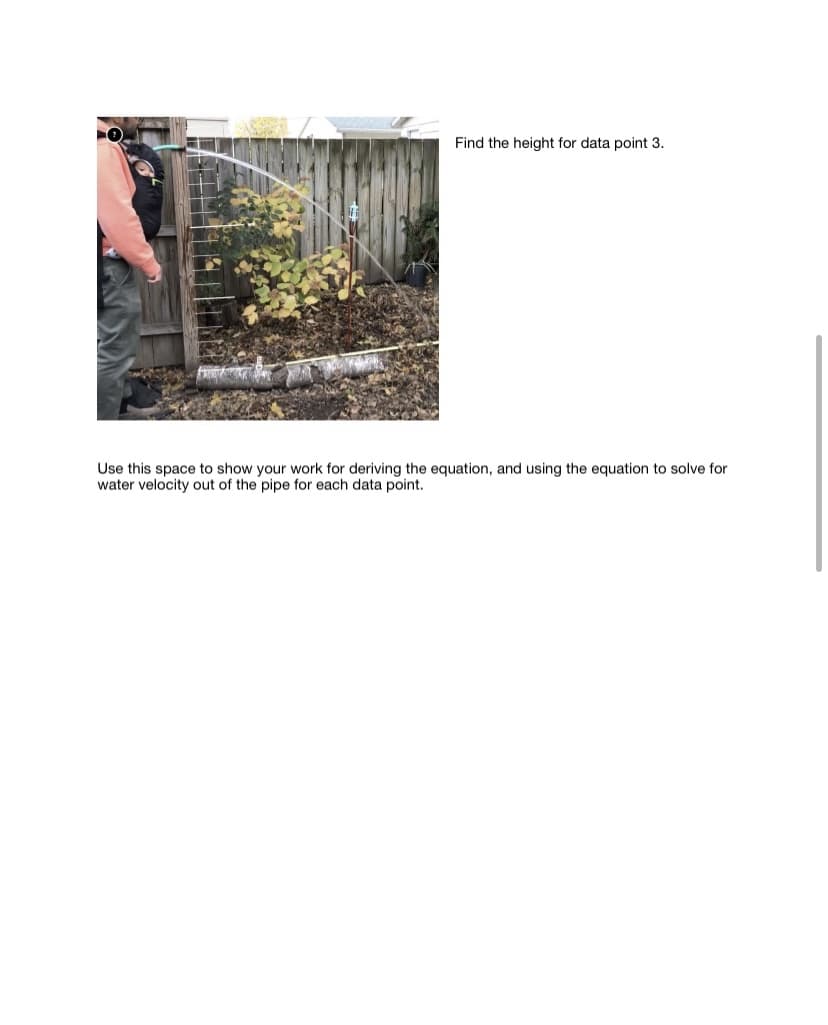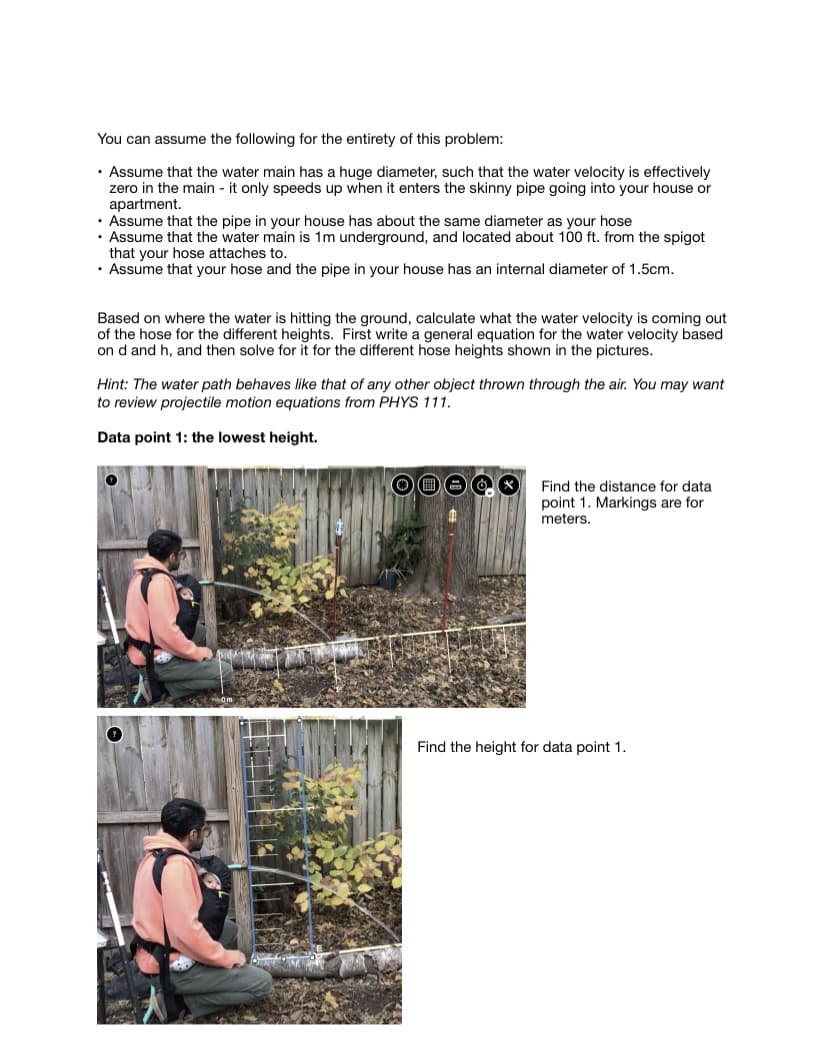• Assume that the water main has a huge diameter, such that the water velocity is effectively zero in the main - it only speeds up when it enters the skinny pipe going into your house or apartment. • Assume that the pipe in your house has about the same diameter as your hose • Assume that the water main is 1m underground, and located about 100 ft. from the spigot that your hose attaches to. • Assume that your hose and the pipe in your house has an internal diameter of 1.5cm. Based on where the water is hitting the ground, calculate what the water velocity is coming out of the hose for the different heights. First write a general equation for the water velocity based on d and h, and then solve for it for the different hose heights shown in the pictures. Hint: The water path behaves like that of any other object thrown through the air. You may want to review projectile motion equations from PHYS 111. Data point 1: the lowest height. OO Find the distance for data point 1. Markings are for meters.
• Assume that the water main has a huge diameter, such that the water velocity is effectively zero in the main - it only speeds up when it enters the skinny pipe going into your house or apartment. • Assume that the pipe in your house has about the same diameter as your hose • Assume that the water main is 1m underground, and located about 100 ft. from the spigot that your hose attaches to. • Assume that your hose and the pipe in your house has an internal diameter of 1.5cm. Based on where the water is hitting the ground, calculate what the water velocity is coming out of the hose for the different heights. First write a general equation for the water velocity based on d and h, and then solve for it for the different hose heights shown in the pictures. Hint: The water path behaves like that of any other object thrown through the air. You may want to review projectile motion equations from PHYS 111. Data point 1: the lowest height. OO Find the distance for data point 1. Markings are for meters.
Elements Of Electromagnetics
7th Edition
ISBN:9780190698614
Author:Sadiku, Matthew N. O.
Publisher:Sadiku, Matthew N. O.
ChapterMA: Math Assessment
Section: Chapter Questions
Problem 1.1MA
Related questions
Question

Transcribed Image Text:O
Find the height for data point 3.
Use this space to show your work for deriving the equation, and using the equation to solve for
water velocity out of the pipe for each data point.

Transcribed Image Text:You can assume the following for the entirety of this problem:
• Assume that the water main has a huge diameter, such that the water velocity is effectively
zero in the main - it only speeds up when it enters the skinny pipe going into your house or
apartment.
• Assume that the pipe in your house has about the same diameter as your hose
• Assume that the water main is 1m underground, and located about 100 ft. from the spigot
that your hose attaches to.
• Assume that your hose and the pipe in your house has an internal diameter of 1.5cm.
Based on where the water is hitting the ground, calculate what the water velocity is coming out
of the hose for the different heights. First write a general equation for the water velocity based.
on d and h, and then solve for it for the different hose heights shown in the pictures.
Hint: The water path behaves like that of any other object thrown through the air. You may want
to review projectile motion equations from PHYS 111.
Data point 1: the lowest height.
Find the distance for data
point 1. Markings are for
meters.
Find the height for data point 1.
Expert Solution
This question has been solved!
Explore an expertly crafted, step-by-step solution for a thorough understanding of key concepts.
This is a popular solution!
Trending now
This is a popular solution!
Step by step
Solved in 2 steps

Knowledge Booster
Learn more about
Need a deep-dive on the concept behind this application? Look no further. Learn more about this topic, mechanical-engineering and related others by exploring similar questions and additional content below.Recommended textbooks for you

Elements Of Electromagnetics
Mechanical Engineering
ISBN:
9780190698614
Author:
Sadiku, Matthew N. O.
Publisher:
Oxford University Press

Mechanics of Materials (10th Edition)
Mechanical Engineering
ISBN:
9780134319650
Author:
Russell C. Hibbeler
Publisher:
PEARSON

Thermodynamics: An Engineering Approach
Mechanical Engineering
ISBN:
9781259822674
Author:
Yunus A. Cengel Dr., Michael A. Boles
Publisher:
McGraw-Hill Education

Elements Of Electromagnetics
Mechanical Engineering
ISBN:
9780190698614
Author:
Sadiku, Matthew N. O.
Publisher:
Oxford University Press

Mechanics of Materials (10th Edition)
Mechanical Engineering
ISBN:
9780134319650
Author:
Russell C. Hibbeler
Publisher:
PEARSON

Thermodynamics: An Engineering Approach
Mechanical Engineering
ISBN:
9781259822674
Author:
Yunus A. Cengel Dr., Michael A. Boles
Publisher:
McGraw-Hill Education

Control Systems Engineering
Mechanical Engineering
ISBN:
9781118170519
Author:
Norman S. Nise
Publisher:
WILEY

Mechanics of Materials (MindTap Course List)
Mechanical Engineering
ISBN:
9781337093347
Author:
Barry J. Goodno, James M. Gere
Publisher:
Cengage Learning

Engineering Mechanics: Statics
Mechanical Engineering
ISBN:
9781118807330
Author:
James L. Meriam, L. G. Kraige, J. N. Bolton
Publisher:
WILEY